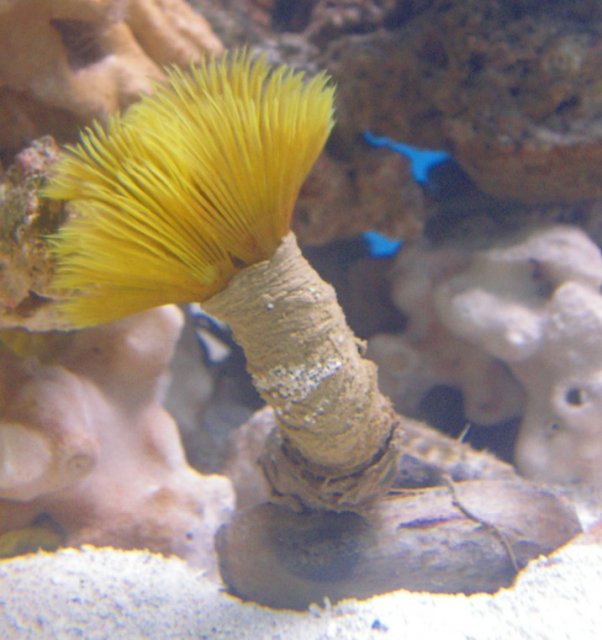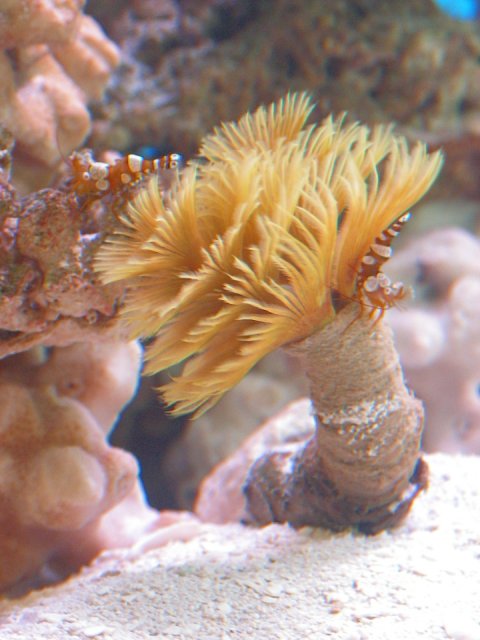feather duster info
- Thread starter fish guru
- Start date
You are using an out of date browser. It may not display this or other websites correctly.
You should upgrade or use an alternative browser.
You should upgrade or use an alternative browser.
sometimes they will leave their tubes. i've heard some ppl think their duster is dead only to find it with a new tube somewhere else months later. i don't think they will usually do this unless something is wrong tho i maybe incorrect about that. it must take a lot for them to do this tho as i had 2 dusters that my clowns killed, you'd think that getting ripped apart by clownfish would be enough to make a duster ditch it's tube and relocate but it wasn't for these 2. i ended up having to cover them with pop bottles for months hoping the clowns would forget about them. in the end when i uncovered them it was all over in a matter of minutes for them... at least i got the 2 baby dusters out of it and my clowns now for whatever reason don't care at all about them... crazy clownfish...
Ok not to take over this thread or anything but I have a question about the difference between feather busters and Coco worms? We bought what we were told was a feather duster but was told by people on here like Grins that it is a Coco worm. So is there a difference? Do you have to do anything different for one and not the other? How long do Coco worms live?
Ok so that's like what four questions! Sorry :O)
Ok so that's like what four questions! Sorry :O)
Ok not to take over this thread or anything but I have a question about the difference between feather busters and Coco worms? We bought what we were told was a feather duster but was told by people on here like Grins that it is a Coco worm. So is there a difference? Do you have to do anything different for one and not the other? How long do Coco worms live?
Ok so that's like what four questions! Sorry :O)
CAN WE SEE A PIC???
Ok not to take over this thread or anything but I have a question about the difference between feather busters and Coco worms? We bought what we were told was a feather duster but was told by people on here like Grins that it is a Coco worm. So is there a difference? Do you have to do anything different for one and not the other? How long do Coco worms live?
Ok so that's like what four questions! Sorry :O)
Get theses answered, then we can return to the origional thread OP...
There is no difference between a feather duster, co-co worm and tube worm..Co-Co worm is just a name for a perticular SP. ....Feather dusters are of the group called sedentariate polychaetes...This encompasses the little tiny feather dusters we see hitch-hiking on live rock, to the pinks/yellow/red etc that are sold and also co-co worms...
No, you dont really have to do anything different from one to another..
Life span can be anything up to around 7 years in a quality environment...
Thanks.....
Get theses answered, then we can return to the origional thread OP...
Dang man, your really going on a "OT" rampage today? Little excessive I think. Especially when Woodrights question IS on topic if you go back to the first post. Someone have too much coffee this morning?
R there anything else that I should know??
I would think learning about the difference between a normal featherduster and a co-co worm would fall under the "Anything else I should know" part. Co-co worms have a hard shell and the other normal featherdusters are soft shelled. Ya, they are in the same family, but they are definately different in their tubes.
Dang man, your really going on a "OT" rampage today? Little excessive I think. Especially when Woodrights question IS on topic if you go back to the first post. Someone have too much coffee this morning?
No, not excessive at all....It confuses threads when there is more than one persons questions in there...
Catpicklesdog
Hindsight is a wonderful thing!
I'm not going to make a habit of this as I think everyone should buy their own books and do their own research, but this is from "A PocketExpert Guide Marine Invertebrates" which I recommend every reef keeper gets. This is what it says about Feather Dusters:
....Feather duster worms are from four common families within the Class Polchaeta, one of the three major classes of the annelids (segmented worms). Although species from each family have some unique attributes, there are many similarities in the biology of all fether duster worms.
Common Characteristics:
All worms in this group have crowns of tentacles used in feeding - these arrangements are the so-called feather dusters.
These crowns are comprised of branched tentacles, with each tentacle's branches arranged like the filaments along a feather
All feather dusters feed on fine particlate organic material, such as phytoplankton and bacterial aggregates, suspended in the water.
All have mechanisms and structural modifications in the tentacles that allow sorting of the filtered particles.....
.... Generally, feather duster worms will do best in areas with moderate to high currents. Lighting is immaterial to their health.........
.......Identification of these worms to family is easy - basically it involves examining the tube. identification to species is also easy for a few common large species.
Family Differences
Family Sabellidae: Tubes are made of a relatively soft material, which may be very flexible or about as stiff as cardboard. Sabellid worms range from very small to quite large. The biggest are over 36 in.(91cm) long, with tentacle crowns over 5 in (13 cm) in diameter. In the aquarium world, these are the animals commonly called "feather duster worms," although the other families have similar feathery crowns. Some smaller species reproduce asexually very well in captivity, forming large colonies.
Family Serpulidae: Tubes are made of calcium carbonate and are often attached to rocks or other substrate material. They frequently have a doubled crown of tentacles, sometimes forming a doubled, tapered helix. They often have an operculum, or plug, that fits into the tube and seals it when the worm has withdrawn. In the aquarium world, these are commonly called "hard-tubed feather dusters", "Christmas tree worms" or "Coco worms".
Family Spirorbidae: These diminutive worms live in small tubes often attached to rocks or growing on the sides of the aquarium. The tightly spiraled tube is seldom over 0.2 in.(5 mm) in diameter. The tentacle cown is bright red or red-orange, but is clearly seen only with magnification. they are and reproduce well in captivity, but are probably never intentionally purchased.
Family Sabellaridae: Tubes are made of cemented sand or other substrate grains. The tentacle crown is generally smaller and less brightly coloured than in the other families. The individual worms seldom exceed 4 in (10cm) in length, but collectively they may form reefs of cemented worm tubes that are hundreds of yards long and up to 66ft (20m) high. These worms are seldom seen in captivity because the aggregations of tubes are simply too difficult to break for the animals to be easily collected. However, individuals may enter tanks attached to live rock.
....Feather duster worms are from four common families within the Class Polchaeta, one of the three major classes of the annelids (segmented worms). Although species from each family have some unique attributes, there are many similarities in the biology of all fether duster worms.
Common Characteristics:
All worms in this group have crowns of tentacles used in feeding - these arrangements are the so-called feather dusters.
These crowns are comprised of branched tentacles, with each tentacle's branches arranged like the filaments along a feather
All feather dusters feed on fine particlate organic material, such as phytoplankton and bacterial aggregates, suspended in the water.
All have mechanisms and structural modifications in the tentacles that allow sorting of the filtered particles.....
.... Generally, feather duster worms will do best in areas with moderate to high currents. Lighting is immaterial to their health.........
.......Identification of these worms to family is easy - basically it involves examining the tube. identification to species is also easy for a few common large species.
Family Differences
Family Sabellidae: Tubes are made of a relatively soft material, which may be very flexible or about as stiff as cardboard. Sabellid worms range from very small to quite large. The biggest are over 36 in.(91cm) long, with tentacle crowns over 5 in (13 cm) in diameter. In the aquarium world, these are the animals commonly called "feather duster worms," although the other families have similar feathery crowns. Some smaller species reproduce asexually very well in captivity, forming large colonies.
Family Serpulidae: Tubes are made of calcium carbonate and are often attached to rocks or other substrate material. They frequently have a doubled crown of tentacles, sometimes forming a doubled, tapered helix. They often have an operculum, or plug, that fits into the tube and seals it when the worm has withdrawn. In the aquarium world, these are commonly called "hard-tubed feather dusters", "Christmas tree worms" or "Coco worms".
Family Spirorbidae: These diminutive worms live in small tubes often attached to rocks or growing on the sides of the aquarium. The tightly spiraled tube is seldom over 0.2 in.(5 mm) in diameter. The tentacle cown is bright red or red-orange, but is clearly seen only with magnification. they are and reproduce well in captivity, but are probably never intentionally purchased.
Family Sabellaridae: Tubes are made of cemented sand or other substrate grains. The tentacle crown is generally smaller and less brightly coloured than in the other families. The individual worms seldom exceed 4 in (10cm) in length, but collectively they may form reefs of cemented worm tubes that are hundreds of yards long and up to 66ft (20m) high. These worms are seldom seen in captivity because the aggregations of tubes are simply too difficult to break for the animals to be easily collected. However, individuals may enter tanks attached to live rock.
Last edited:




